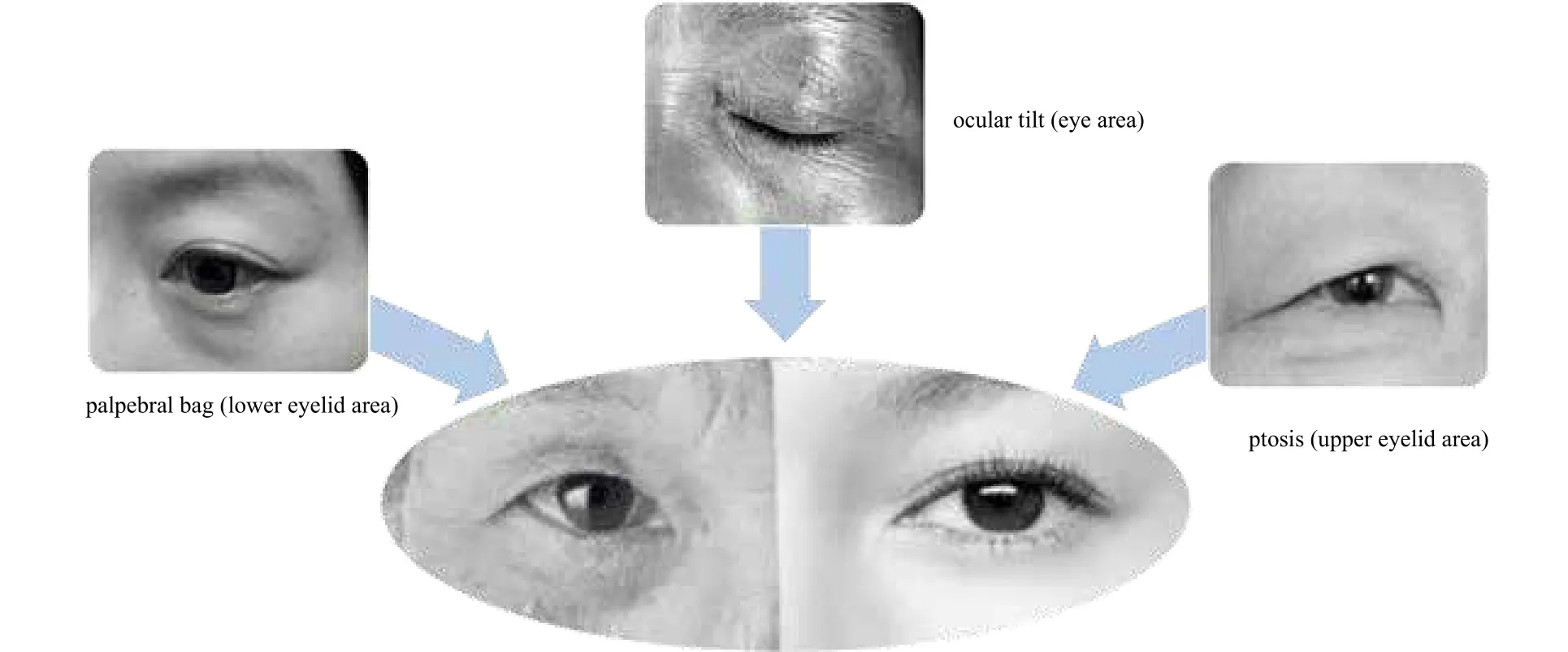Application of “Youthful Curve of Ocular Region” in the Research of Asians Aging
Cui Jianjie, Wu Yue, Jiang Lili, Huang Chen
Department of R&D Center, Jala Group, China
The ocular contour is relevant to concave-convex bones and fillings of subcutaneous soft tissues. Tissues that fill the skin will lose with age. Under the action of gravity, soft tissues in the ocular region are sagging, accompanying with such ocular aging features as palpebral bag and ocular tilt.Compared with the eyelids of Westerners, the eyelids of Asian people have more subcutaneous fat and orbicularis oculi fat, as a result, the effect of gravity on the ocular regions of Asian people may be more serious, so we focused on the eyes of Asian people.
By searching for relevant literature, we found that the most important aging features of the ocular region under the action of gravity include palpebral bag (lower eyelid area), ocular tilt (eye area) and ptosis (upper eyelid area), as shown in Figure 1. We collected photos of a large number of Asian subjects, performed data analysis on these aging features, and researched the change rule of ocular aging features in different age groups. In addition,we performed regression analysis on the resulting data and age in the hope of finding factors most relevant to the ocular age, and established mathematical model in the hope of assessing the improvement of appearance age of the ocular region with cosmetics through this mathematical model.

Figure 1. Aging features of ocular region under the action of gravity
Research process
Research on the aging trend of ocular regions of Chinese
Healthy, well-developed and well-featured Chinese women were included as respondents, excluding those with facial diseases, scars, facial surgery, obesity or those who might interfere with the research. These respondents were grouped by every 10 years (20 to 29 years old, 30 to 39 years old, 40 to 49 years old, 50 to 60 years old), and the number of each group of respondents was larger than 60 (269 respondents in total). All respondents completed the informed consent form after fully understanding the nature, objective and content of the research. Before taking photos, all respondents were required to thoroughly clean their faces, and then took a 30-minute break in rooms at a controlled temperature of 22 ± 2℃ and a relative humidity of 50% to 60%.
The full-face photos of all respondents were taken by a face photo capture device Visia-CR in parallel-polarization mode with its built-in scale.
Images of the photos were subject to length calibration by Image-Pro Plus image analysis software to associate the image pixel with the length, and then the images were subject to angle analysis and length analysis to obtain x1, x2, x3and x4values, as shown in Figure 2. Where, x1is the length of palpebral fissure, in cm; x2is the length of the inferior border of upper eyelid, in cm; x3is the distance between the inferior border of palpebral bag and the midpoint of palpebral fissure, in cm; and x4is the angle between palpebral fissure and the facial midline, in °. And one-way analysis of variance was carried out on the data by the data analysis software SPSS Statistics 20.0 (IBM).

Figure 2. Analysis on aging of ocular region
Establishment of aging regression model of ocular region
During the research, we selected 269 subjects. In the large-scale sampling, we assumed that the appearance age of ocular region was consistent with the real age, we thus used the real age instead of the appearance age in the research on the eye aging trend. According to the actual age y of all respondents and the x1, x2, x3and x4values obtained, we performed step regression model analysis,performed R test, F test and t test on the established regression model, and obtained a regression equation.
Assessment of changes in appearance age of ocular region by using the regression equation
A total of 34 eligible Asian female volunteers were selected. These volunteers shall meet the following conditions: Chinese women aged between 35 to 55 years old, with eye skin relaxation, but without serious systemic diseases, immunodeficiency or autoimmune diseases.During the test, these volunteers only apply “Eye Cream”with cedrus deodara wool oil around eyes and the eye massage, once in the morning and once in the evening for successively 8 weeks. During the test, these volunteers were not allowed to use any product other than the test product. Full-face photos were taken before using this product, after using this product for 4 weeks and 8 weeks respectively, and the images were subject to angle analysis and length analysis. Appearance age fitting was performed by using the regression equation obtained, and one-way analysis of variance was carried out on the data by the data analysis software SPSS Statistics 20.0.

Figure 3. Change curve of aging in all parts of the ocular region
Results
Research on eye aging trend of Chinese
Analysis results of length of palpebral fissure and length of the inferior border of upper eyelid
The age of the respondents increased from 20 years old to 60 years old, the average length of palpebral fissure increased gradually from 2.62 cm to 2.72 cm, with an increase of 3.82%, and the average length of the inferior border of upper eyelid increased gradually from 2.63 cm to 2.74 cm, with an increase of 4.18%. Compared with the 20~29 age group, the 50~60 age group had significant difference. Refer to Figure 4(a), (b) for the test results.
Analysis result of distance between the inferior border of palpebral bag and the midpoint of palpebral fissure
The age of the respondents increased from 20 years old to 60 years old, the average distance between the inferior border of palpebral bag and the midpoint of palpebral fissure increased gradually from 1.47 cm to 1.97 cm, with an increase of 34.01%. Compared with the 20~29 age group, other groups (30-39 years old and above) had significant difference, and the 50~60 age group had the maximum displacement. Refer to Figure 4(c) for the test results.

Analysis result of angle between palpebral fissure and the facial midline
The age of the respondents increased from 20 years old to 60 years old, and the average included angle between eyes and the facial midline increased from 89.71°to 91.50°, with an increase of 1.79°. Compared with the 20 ~ 29 age group, other groups (40 ~ 49 years old and above) had significant difference. Refer to Figure 4(d) for the test results.
Establishment of aging assessment model of ocular region
According to the prediction on the relative importance of four parameters (x1, x2, x3, x4) it was found that the relative importance of x3(distance between the inferior border of palpebral bag and the midpoint of palpebral fissure) to age was the most (up to 0.952),with significance p<0.001, followed by x4(angle between palpebral fissure and the facial midline) (up to 0.035),with significance p=0.012. The relative importance of other parameters x1and x2to age was less than 0.01,without significance, as shown in Figure 4.
Regression model analysis was carried out on age(y), x3and x4to obtain a regression equation y=27.049x3+0.518x4-55.028. The correlation coefficient R of the model was 0.711, indicating that the equation had good fitting. When F test was carried out on the regression model by ANOVA, F value of the model was 115.722(p<0.05), indicating that the equation had statistical significance. When t test was carried out on the intercept of the regression equation, x3and x4, p value was less than 0.05, indicating that both x3and x4had significant effect.


Figure 4. Schematic diagram of relative importance
We connected the palpebral fissure with the inferior border of palpebral bag with a line, established a curve to describe changes in the ocular contour, and named the curve “Youthful Curve of Ocular Region”, as shown in Figure 6. This curve went through the regions of upper and lower eyelid area and palpebral bags area.
Assessment of changes in appearance age of ocular region by using the regression equation
After using the test product for 8 weeks, the volunteers had the appearance age of ocular region decreased by 2.13 years, from 39.23 years old to 37.10 years old, it had significance. Refer to Figure 5 and Figure 6 for the result.

Figure 5. Significant change in appearance age of ocular region after using the eye cream for 2 months

(a or a’) angle between palpebral fissure and the facial midline; (b or b’) distance between the inferior border of palpebral bag and the midpoint of palpebral fissure; (c or c’) youthful curve of ocular region
Discussion
The main reasons for the aging of ocular region are volume loss of fat and the action of gravity in ocular region. During the aging of ocular region, soft tissues(especially subcutaneous fat pads) begin to slide slowly.These problems such as larger palpebral bag, ocular tilt and ptosis of upper eyelid in ocular region will affect the ocular contour. According to the result, it can be found that the most significant factor affecting the ocular contour is palpebral bag with aging between 20 to 60 years old, followed by ocular tilt.
Due to different genetic factors, living environment,geographic locations and living habits, there is difference between the sensory age and real age of people, and everyone has his own appearance age. The ocular region is known as the window of the mind, it is an important area to assess the appearance age of a person. The findings suggested that the aging of ocular region had a good correlation with larger palpebral bag and ocular tilt, and a regression equation of the “Youthful Curve of Ocular Region” was established accordingly.
The “Youthful Curve of Ocular Region” can be used as a tool to assess the appearance age of ocular region.As Asian people have more subcutaneous fat in ocular region, their aging may have more serious effect on the ocular contour, as a result, changes in the “Youthful Curve of Ocular Region” of Asian people may be more obvious.Therefore, the “Youthful Curve of Ocular Region” may be more suitable for the assessment of the aging of Asian people. We also assessed the appearance age of ocular regions of these respondents before and after using this product by using the regression equation. The appearance age of ocular regions of the subjects was significantly younger after using the eye cream for 2 months, which indicated that the eye cream together with massage had the effect of improving the age of ocular region, and also indicated that the multiple linear regression model of the “Youthful Curve of Ocular Region” can be used for research on anti-aging effects of eye cosmetics.
Anti-aging is a life-long effort, people at 20 to 29 years old need to make some preliminary anti-aging work to resist palpebral bags. People at 30 to 39 years old and above also have to make efforts to prevent ocular tilt.Palpebral bag and ocular tilt are the main factors that affect the shape of the "Youthful Curve of Ocular Region".If the two factors can be resisted or repaired by means of cosmetology, skincare and surgery, the eyes will look more glowing with health and radiating vigor, and people will look much younger.
[1] SR Coleman; R Grover. The Anatomy of the Aging Face:Volume Loss and Changes in 3-Dimensional Topography.Aesthetic Surg J, 2006, 26(suppl):S4-S9.
[2] Bryan Mendelson;Chin-Ho Wong. Changes in the facial skeleton with aging: implications and clinical applications in facial rejuvenation. Aesthetic Plastic Surgery 2012, 36(4),753-760.
[3] S Jeong; BN Lemke. The Asian upper eyelid: an anatomical study with comparison to the caucasian eyelid. Arch Ophthalmol 1999, 117(7), 907-912.
 China Detergent & Cosmetics2018年2期
China Detergent & Cosmetics2018年2期
- China Detergent & Cosmetics的其它文章
- New Chinese Laundry Pods Standard to Launch
- L’Oréal Tops Most Valuable Personal Care brand List
- Alibaba Encourages Canadian SME Growth in China
- Meet Our New Editorial Board Member:Richard Leroux
- Sensory Evaluation of Hydroxy Ethyl Cellulose (HEC) in Facial Mask
- Beiersdorf Grows E-commerce Presence in China
